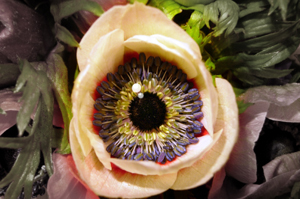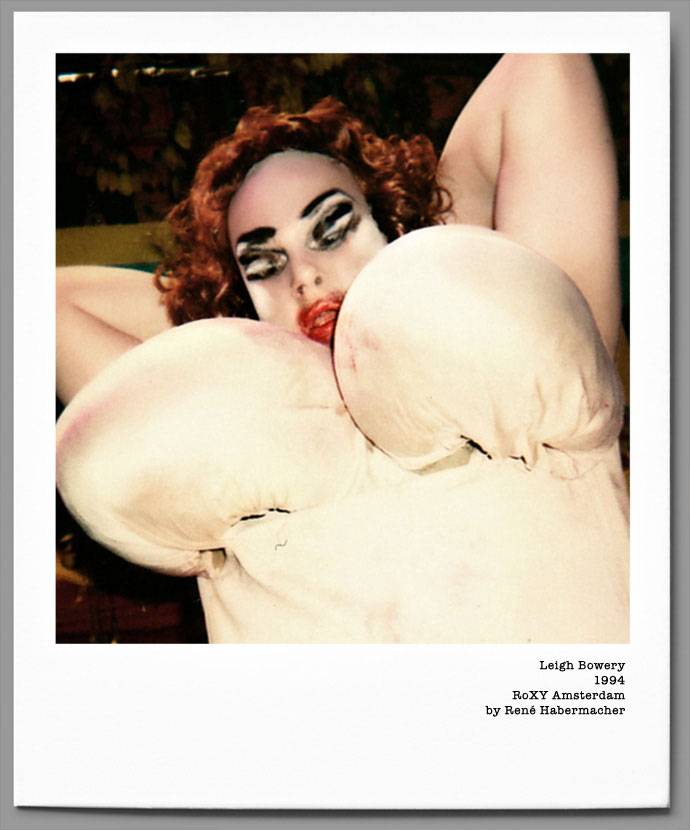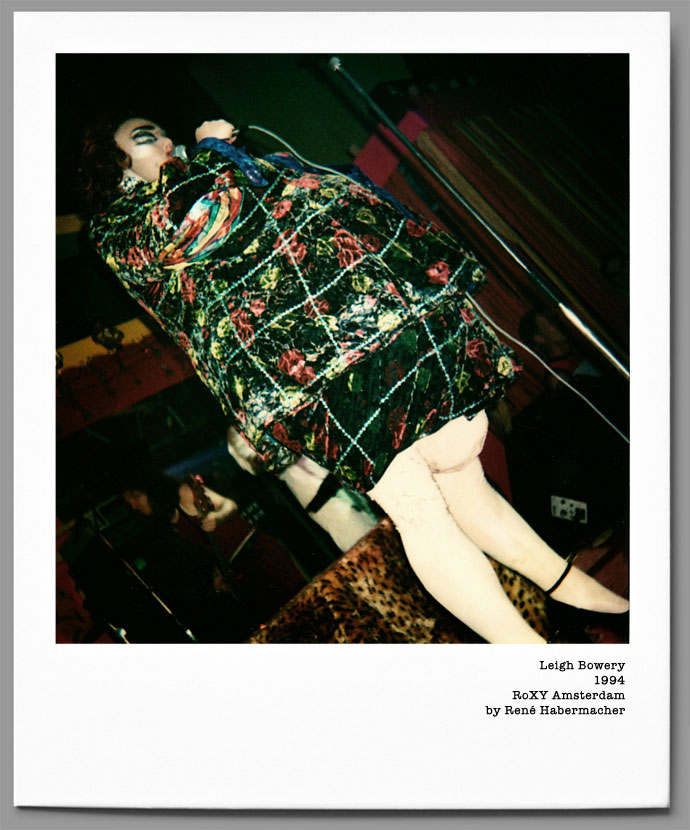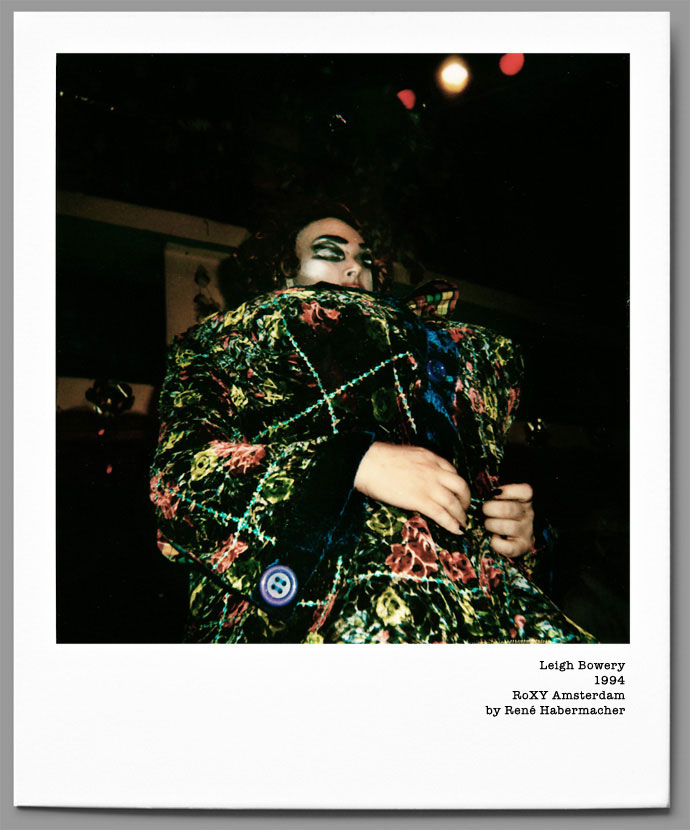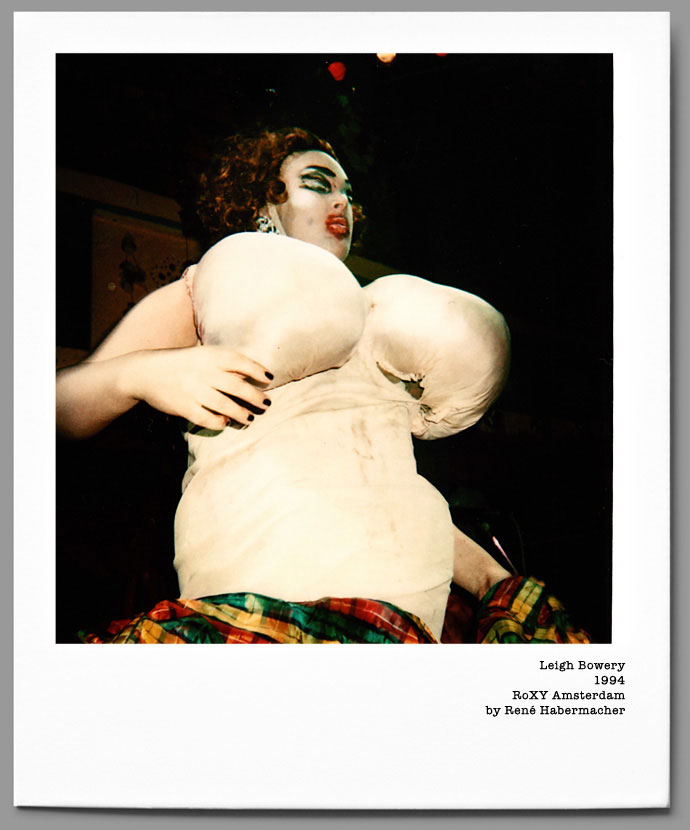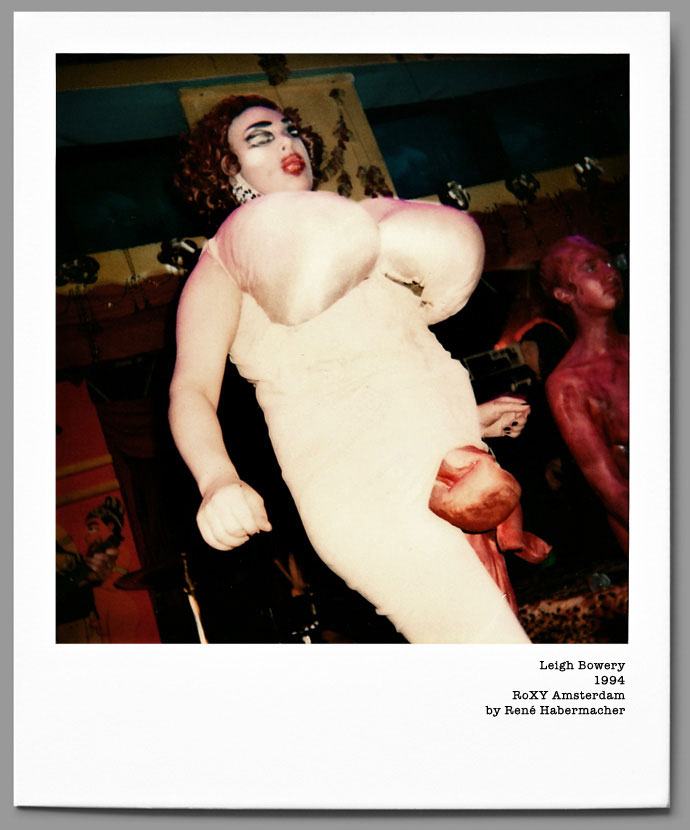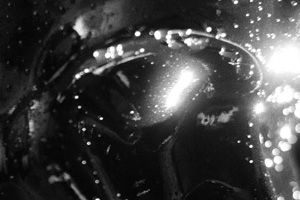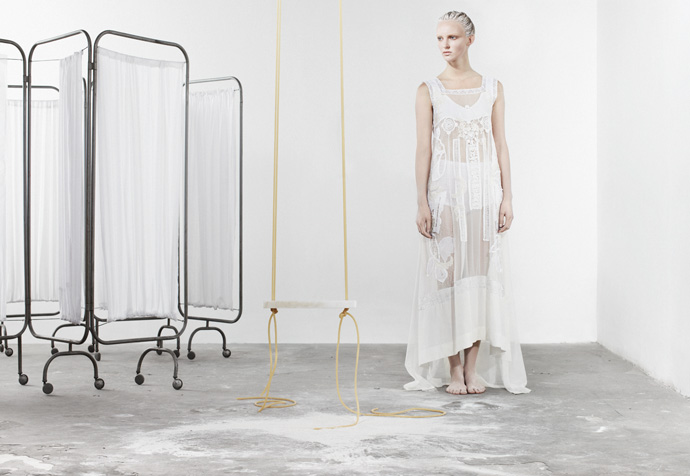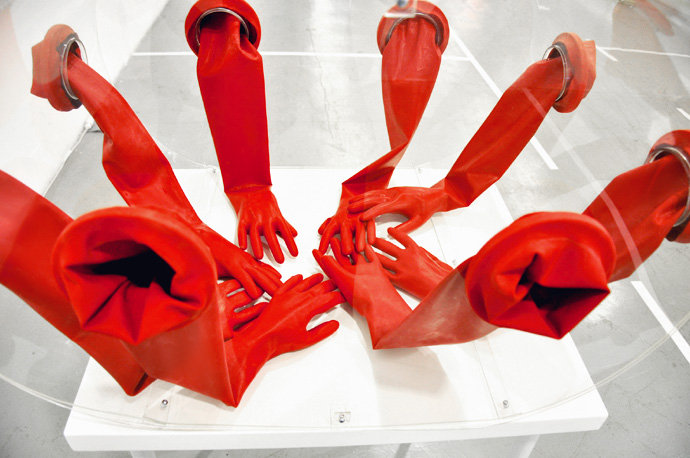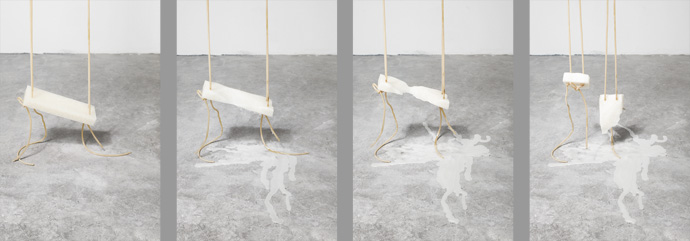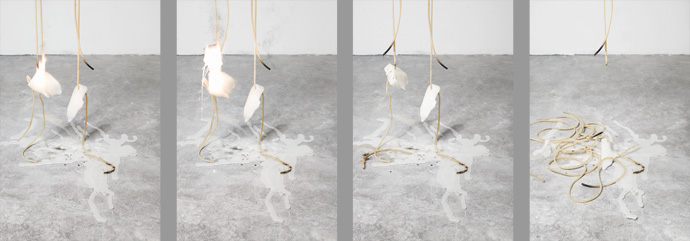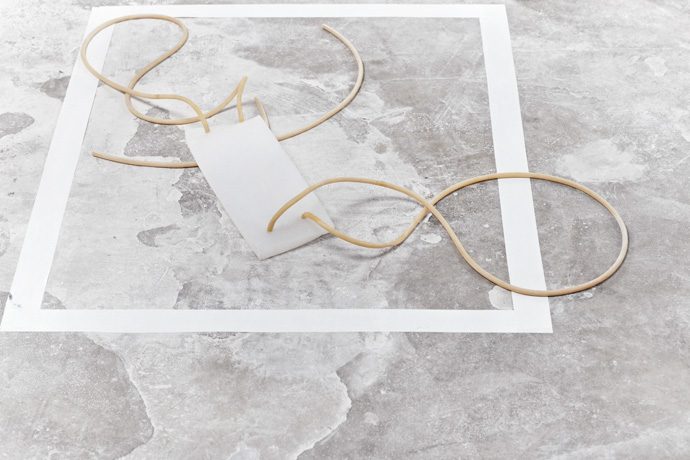-

MATT PYKE AND FRIENDS: that idea of foreverness
-The future is back.
That’s the impression you get from Matt Pyke’s new show at Gaîté Lyrique, Paris’ brand new digital creation center. Mutating monsters, illuminated silences, evolving creatures, disintegrating dancers, glowing trees… Pyke and his friends from the studio Universal Everything use every corner of new-old parisian theater to make your head swirl. Literally.
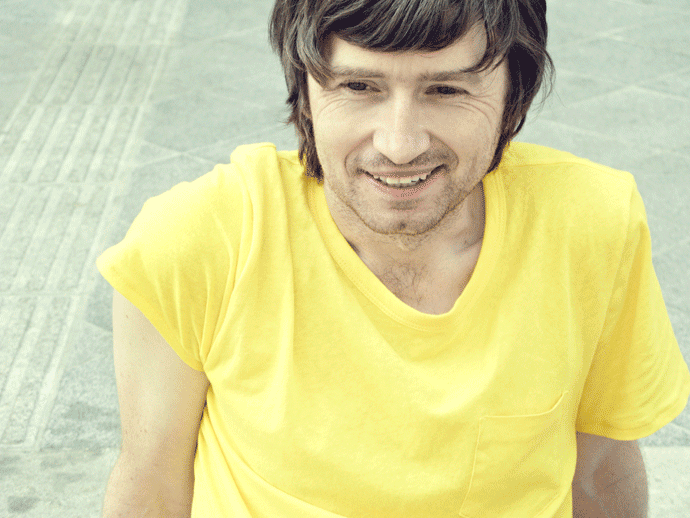 Meet Matt Pyke. Photo by René Habermacher
Meet Matt Pyke. Photo by René HabermacherANTOINE ASSERAF: I noticed everything is looping, there is no beginning and no end. What as your intention with that?
MATT PYKE: One of the reasons for the looping is we’re really interested in the idea of infinity and how it creates video artworks which don’t really have a narrative story to them.
We’re creating almost a video sculpture, a state of mind or a trance-like situation: for example where dancers that are continually struggling up the wall to get to the sound or the giant walking monster in TRANSFIGURATION which is walking forever and nobody knows where he is going.
It’s that idea of foreverness and how you can use video to do that as an artwork that never stops: everything is almost like a machine that is going and going…
Matt Pyke & Friends : Super-Computer-Romantics
Sometimes you have some very un-digital elements like drawing.
I studied drawing and painting at art school and still find it very important to have a pencil as well as a computer. All of the artworks were based on drawings originally. The archive of the Gaîté Lyrique has a collection with all the working drawings from all the artpieces.
In the exhibition, the one called SEVENTY SIX SEEDS was entirely created through drawing but influenced by the more recent years where i’ve been working with people who use codes. The drawings are very much influenced by digital processes and the shapes that code make.
We’ve made an iPhone application that gave me kind of genetic instructions of what type of seed what type of plant to draw every morning- so it’s a way of using technology to control me, control my pencil.
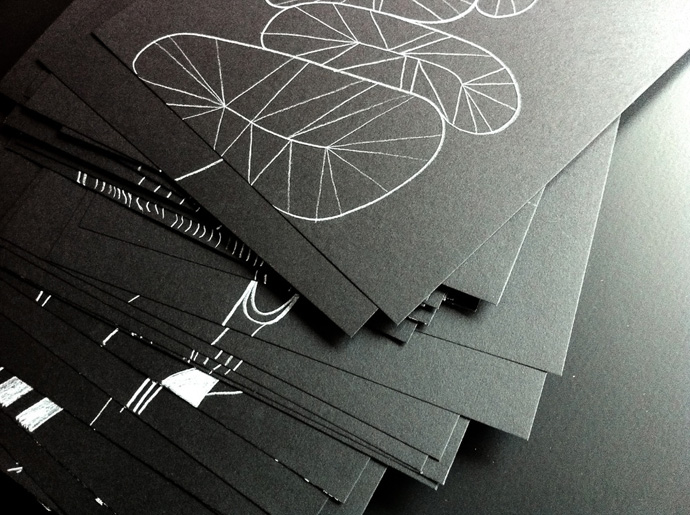
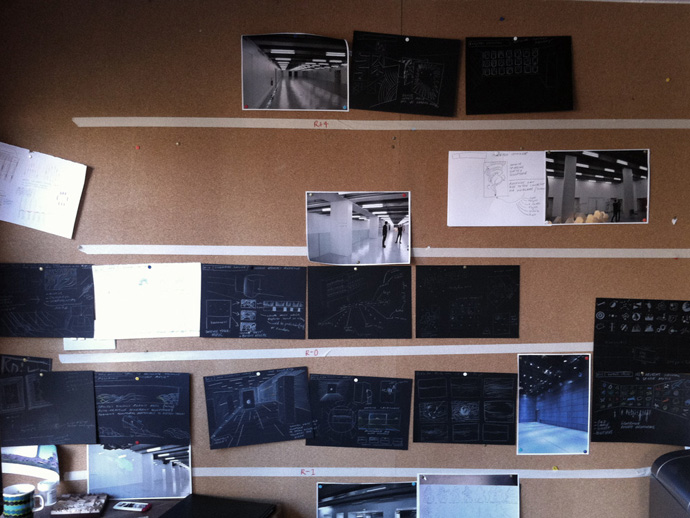 Works in Progress: left Matt Pykes drawings for SEVENTY SIX SEEDS inspired after an iPhone application.
Images Courtesy of Matt Pyke
Works in Progress: left Matt Pykes drawings for SEVENTY SIX SEEDS inspired after an iPhone application.
Images Courtesy of Matt PykeDo you code and program yourself or are you trying to bring that kind of “old school” thinking into that?
I intentionally do not code and program myself. I tried to learn and found it did not suit me, so I focus on the conceptual side of things and the visual side of things in terms of art direction and creative direction and come up with the initial seed idea and then work with programmers who are genuinely experts or super talent in their field.
I think one important thing is, by me not understanding code, that my ideas are not restricted to what is possible.
00 -

next: MATT PYKE
-It’s a strange one but I’ve been learning tennis for two years because I needed to learn a sport.
I won my first tennis match last week —it’s a completely different way of using your arm then clicking a mouse.
So that’s what stimulated me, just a completely different perspective! -

-

next: PANDELIS CHANDRIS
-“The same thing stimulated me for the last 20 years and I do not know what it is…”
-

NJA MAHDAOUI: strokes of liberation
-Nja Mahdaoui is one of the most celebrated living contemporary artists in the arab world. His bold and highly rhythmic work, derived from the arabic letter, is internationally renowned and can be found in ther permanent collections of the Institut du Monde Arabe, The British Museum and The Smithsonian Institution just to name a few.
It’s an exuberance of arabesque forms, a visual melody played out of his hand, that remind us of the great gestural and physical richness of action painting. Famous for his meticulous inks on parchment, this “liberated calligraphy” is worked across a variety of extremely different surfaces — from canvas, brass, wood, melamine and papyrus to skin. Though It seems like writing, it is not. It is rather an interlacing of a dialectic relationship, also found within Western abstraction.
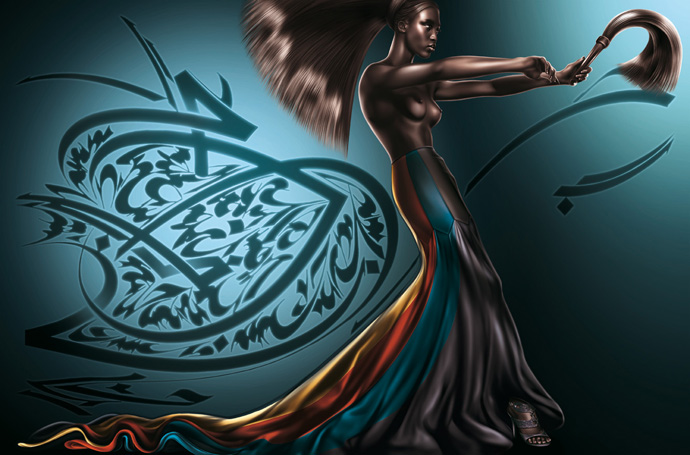 Naomi Campbell in Azzedine Alaïa for Numéro Magazine. A collaboration between Nja Mahdaoui and René Habermacher
Naomi Campbell in Azzedine Alaïa for Numéro Magazine. A collaboration between Nja Mahdaoui and René HabermacherI came across the work of Nja Mahdaoui the first time, while researching calligraphic styles on a project for the French magazine Numéro on a piece about Azzedine Alaïa to which Babeth Djian incited me. The visual impact of Nja’s work struck me at first sight.
Slightly intimidated by the references of the rich body of his work, I first hesitated but then thought to give it a shot, and contacted him. To my surprise he answered me instantly by email, and called me shortly after. Our collaboration was set — and we created a story of imaginary movements around Naomi Campbell as a dark gazelle, in sheer and revealing Alaïa.
But I only met Nja Mahdaoui in person two summers ago in Tunis. It was an all-embracing, hot and sultry August day that lay heavy on the city, matching the emotional state of its people.
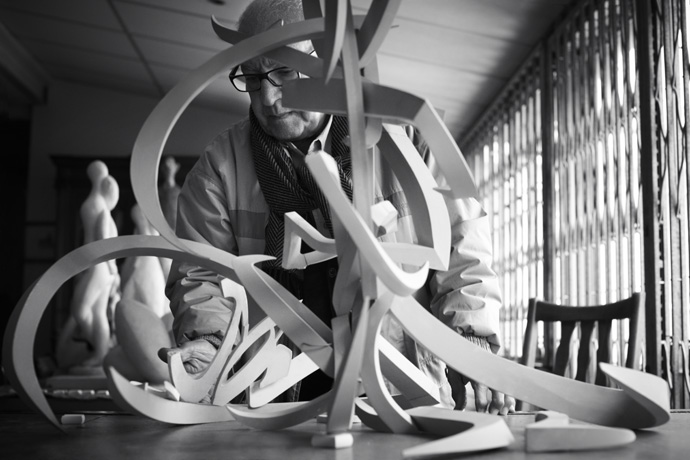 Nja Mahdaoui wit the first prototype of his most recent sculpture. Photography by René Habermacher
Nja Mahdaoui wit the first prototype of his most recent sculpture. Photography by René HabermacherA couple of months after the “Jasmine revolution” took place, Nja arrives in full swing to our meeting at a café in sunny, springtime Paris.
He’d come with his daughter Molka Mahdaoui to work on another of his new projects, yet is consumed with excitement by the events. He reacts immediately and impulsively to the question I usually ask last on conversations for The Stimuleye: What is the last thing that stimulated you?
“Stimulated? You’re asking a Tunisian? (laughs). I don’t know if ‘stimulated’ is the word, but it’s the explosion of a generation, I’m completely into it — for us it’s the event of the century!”
 Nja Mahdaoui: "Graphemes on Arches 2", 2009, Ink on arches paper; 135cm x 135cm.
Nja Mahdaoui: "Graphemes on Arches 2", 2009, Ink on arches paper; 135cm x 135cm.With us at the table are the collaborators involved in the process of making his latest project, a sculpture, the main reason for his trip north. Nja loves collaborations – his eyes glow while he talks energetically about upcoming projects. An energy I felt the first time I saw his bold and highly rhythmic work: “a dance of calligraphy”, with Nja as the choreographer of imaginary letters, to which he refers as ‘graphemes’, devoid of actual textual meaning:
“To a non-Arabic speaker it appears as coherent text. In fact even Arabic speakers assume at first that it’s a text with meaning. But when they start reading it they realise it is not an actual word.” he says and recalls an experience:
“It is not easy to write letters in a disjointed way — that is disjointed to not mean anything — and focus only on the aesthetic. There was a study at the California Institute of Technology in Pasadena. They connected me to a machine in order to test the levels of stress my body was under when I was writing proper words and when I was writing words without meaning. The study showed that my body was 2.5 times more stressed when I was working on words without meaning. So it is a very conscious attempt to create art. I tell people I’m not a calligrapher, but an artist.”
To me his body of work is so vibrant and remarkably innovative that I first had assumed Nja to be in his early 30’s the most, yet he was born in La Marsa, Tunisia, in 1937. As Molka, a filmmaker herself, puts it during our conversation: “sometimes i have to remind myself: Molka, you are thinking older than your own father!”.
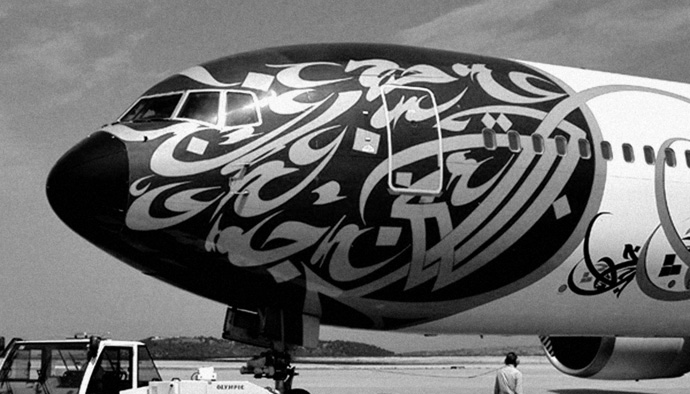 Nja Mahdaoui: Design for Gulf Air 50th Anniversary. Image Courtesy of Nja Mahdaoui
Nja Mahdaoui: Design for Gulf Air 50th Anniversary. Image Courtesy of Nja Mahdaoui -

Out of the box: LEIGH BOWERY
-The other day i was going through boxes of photographs between sheltering sheets of cellophane. I came across a reminiscence from a time when I was obsessed with polaroids: a series of shots that I had taken from artist Leigh Bowery, in what was probably one of his last performances in late May 1994.
Leigh Bowery performing at the RoXY Amsterdam on May 17 1994. Polaroid by René Habermacher.
It was a party at the legendary RoXY club Amsterdam, with Boy George and Robert Owens on the turntables and leading clubbers Sheila Tequila and Stella Stein appearing, to the bemusement of the crowd, nude with pubic wigs only.
That Night Leigh Bowery presented his classc “Birth Show” together with Nicola Bateman-Bowery, whom he had married just 3 days before.As usual for Leigh, the performance, an homage to John Waters “Female Trouble”, would attack the spectators sensitivities- which even worked for the notorious Roxy audience: Leigh would appear to enter the stage in what seemed a rather conservative flower dress to sing with his band Minty, but toward the middle of the song birthed his partner Nicola, who was held under his costume upside down using a specially-designed harness. Nicola then appeared as a very large baby covered in placenta.Leigh died later that year on New Year’s Eve from an AIDS-related illness. A death bed pronouncement by “Modern Art on legs”, as Boy George commented, was: “Tell them I’ve gone pig farming in Bolivia”.
Leigh Bowery and his wife Nicola Bateman-Bowery, then freshly wed. Polaroids by René Habermacher.
It was one of these Spectacles that made the RoXY’s infamous reputation. Not only a club, the RoXY was an Institution. A playground and battlefield for artists. While mingling among the glitterati and club kids of the time I recall seeing there first time the work of Inez Van Laamsweerde and Vinoodh Matadin on a flyer- or a toilet exhibition of Erwin Olafs photographs, an explicit series that was was by far outreached by what was going on in these restrooms…
Founder Pieter Giele’s Motto AB IGNE IGNEM CAPERE (one fire ignites another) came true some years later. The Club that operated from 1987 in a splendid old theatre on Prinsengracht went up in flames the day of Pieter Giele’s Funeral in 1999 and burned down to the ground.
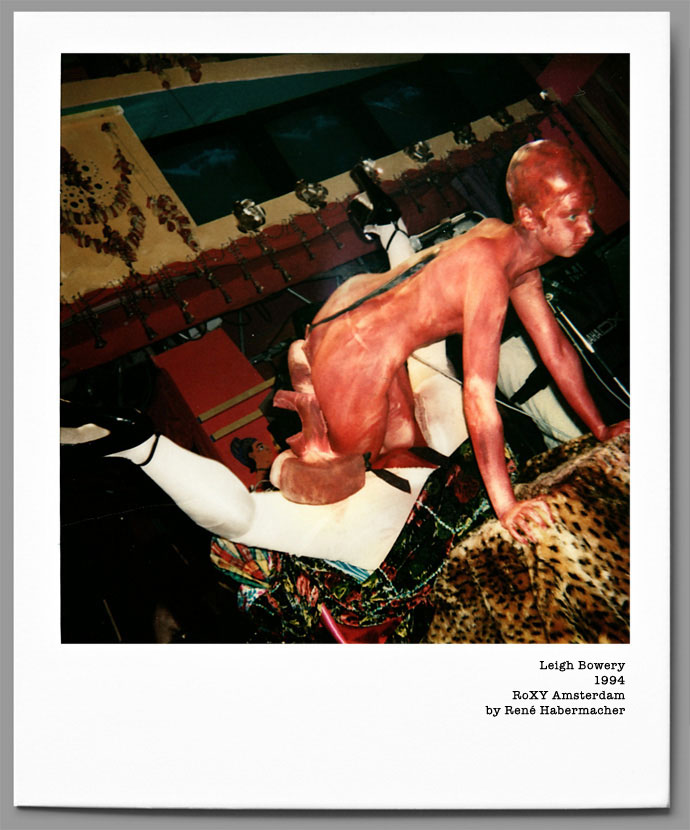
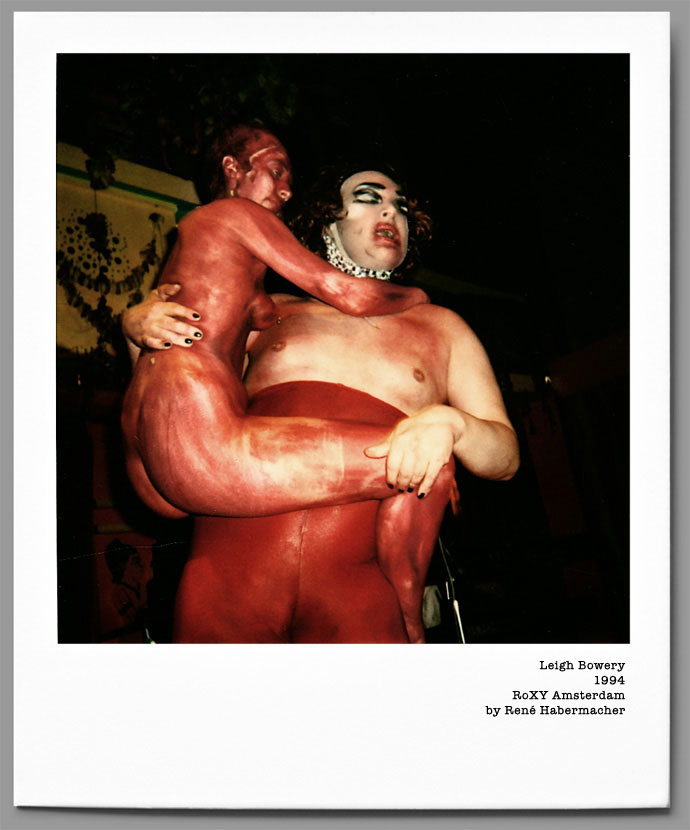
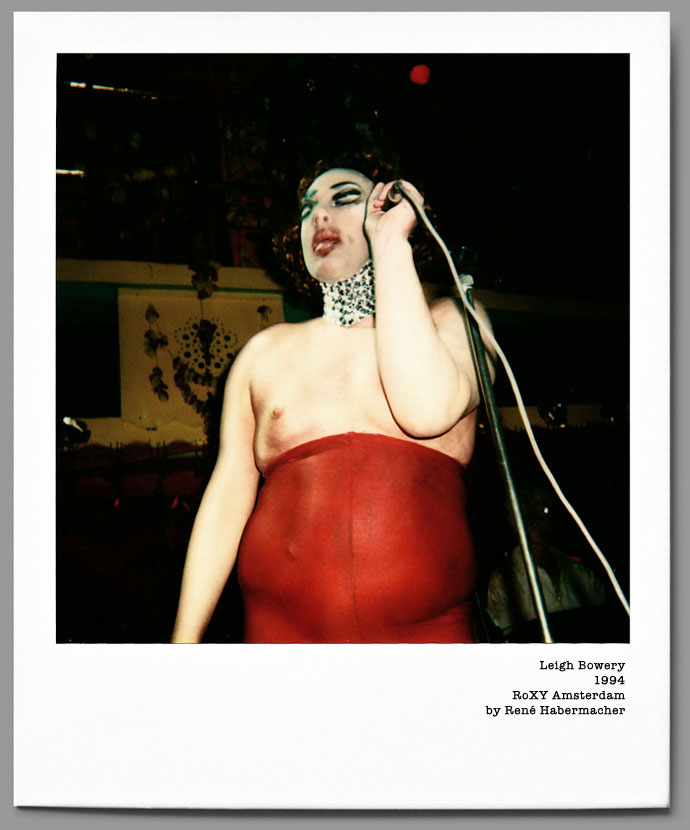
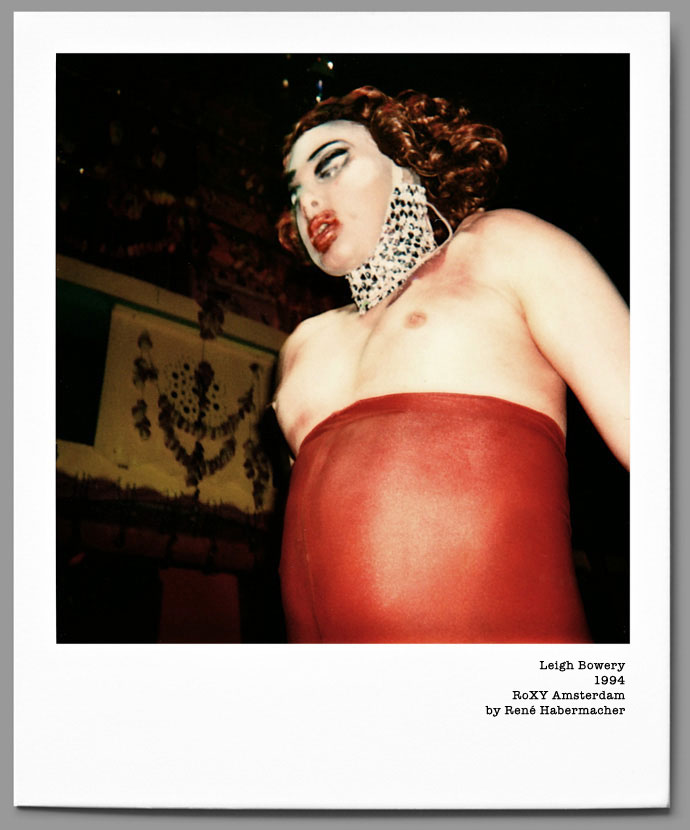
Leigh Bowery on stage with the MINTY. Polaroids by René Habermacher.An exhibition of photos by the club’s photographer Cleo Campert will be on show later this summer at the LUX Photo Gallery Amsterdam from 18 June – 18 July: The RoXY Years / De RoXY Jaren
Cleo Campert: “In this show I emphasize the open sexuality and the indecent exposure which reigned in the famous night club RoXY in Amsterdam in the early nineties.” -

-

rising hope
-For days we have watched in awe the dramatic events unfolding in Japan, following the news that show big parts of that highly sophisticated and industrialised country laying in scatters what looks like aftermath of a war, one cannot but be impressed by the calm and altruistic spirit of the people reacting to this tragedy.
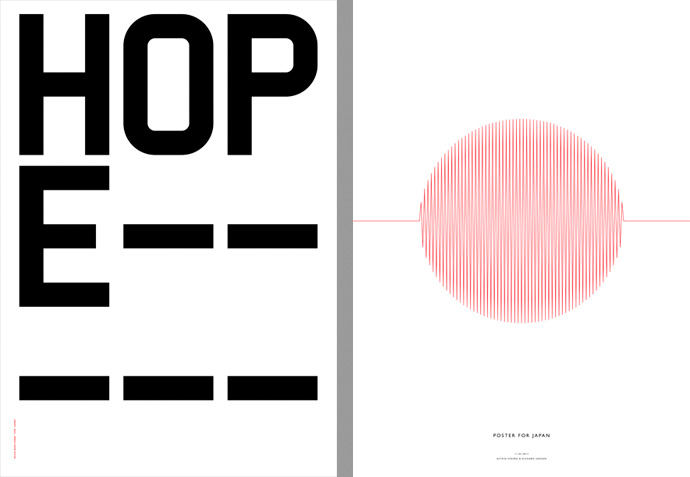 WORD POWER [JAPAN] by Build and POSTER FOR JAPAN by Astrid Stavro & Richard Sarson
WORD POWER [JAPAN] by Build and POSTER FOR JAPAN by Astrid Stavro & Richard SarsonPerhaps even more impressive than Japan’s technological power is its social strength:
Supermarkets cut prices, vending machine owners giving out free drinks and restaurant owners handing out free food as people work together to survive.
Nippon, that seemed in “hyber-nation” for the last decades of economic decline, with its population alienated and facing a lethargic new generation is putting an incredible collective solidarity on display. We can only guess what impact this catastrophe will leave on the collective consciousness of the japanese in the long run. As Japanese writer Ryu Murakami puts it in The New York Times:
“Ten years ago I wrote a novel in which a middle-school student, delivering a speech before Parliament, says: “This country has everything. You can find whatever you want here. The only thing you can’t find is hope.”
One might say the opposite today: evacuation centers are facing serious shortages of food, water and medicine; there are shortages of goods and power in the Tokyo area as well. Our way of life is threatened, and the government and utility companies have not responded adequately.
But for all we’ve lost, hope is in fact one thing we Japanese have regained. The great earthquake and tsunami have robbed us of many lives and resources. But we who were so intoxicated with our own prosperity have once again planted the seed of hope. So I choose to believe.”
(NYT of March 16, translated from Japanese by by Ralph F. McCarthy)
The altruistic spirit people encounter these days in Japan on their road to recovery manifest itself in a myriad of small stories. Inspired by this, Jun Shiomitsu, student at University of Cambridge created a blog “Voices from Japan” together with ten of his classmates and friends, sharing tweets from japanese twitter accounts. Some of these short messages, proof on personal experiences, we would like to share with you following. For more please see “Voices from Japan”.
This article is illustrated with posters from Designers for Japan, a collaborative bringing designers and imagemakers together to aid relief efforts “and to express our love and respect for our friends in Japan”.The poster sales profit will go directly to The Red Cross and Shelterbox.Direct donations for Japan can also be made at: Red Cross Japan
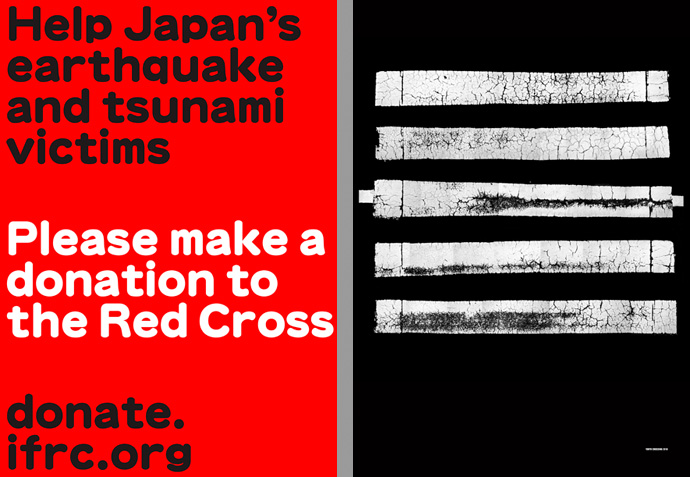 DONATE... by Practice and TOKYO CROSSINGS by Fabian Monheim
DONATE... by Practice and TOKYO CROSSINGS by Fabian MonheimThis earthquake has reminded me of that Japanese goodness that had recently become harder and harder to see. Today I see no crime or looting: I am reminded once again of the good Japanese spirit of helping one another, of propriety, and of gentleness. I had recently begun to regard my modern countrymen as cold people … but this earthquake has revived and given back to all of us the spirit of “kizuna” (bond, trust, sharing, the human connection). I am very touched. I am brought to tears.
(Original Japanese text) * 日本人の良さを再認識
この地震が、きっかけになって、失いかけていた日本人本来の良さが戒間見れた気がする。犯罪はする様子はなく、助け合い、律儀、紳士的。普段日本人は冷たい人が多い…。って個人的に感じてるんだけど、多くの人が今回で「絆」を取り戻しつつあるように見えて、それがなんか感動して、泣けてくる。
— アジアの架け橋 Suzuki Viet (@VietL) March 12, 2011
この地震が、きっかけになって、失いかけていた日本人本来の良さが戒間見れた気がする。犯罪はする様子はなく、助け合い、律儀、紳士的。普段日本人は冷たい人が多い…。って個人的に感じてるんだけど、多くの人が今回で「絆」を取り戻しつつあるように見えて、それがなんか感動して、泣けてくる。
My Boyfriend, Off with His Rescue Unit
Yesterday, I said goodbye to my loved one as he left for one of the hardest-hit areas, Minami Sanriku in Miyagi. He is a member of the Fire Department’s special rescue unit. As I bade him goodbye, I asked “Are you scared?” He simply answered “I just feel sorry for those people whose bodies are still buried and cold and lonely. I just want to help find their bodies as soon as possible so that they can be returned to their families.” This from my boyfriend who is normally so shy he can’t go shopping for clothes by himself. Seeing his quiet resolve, I stifled my tears and sent him off with a smile.
(Original Japanese Text)
http://twitter.com/_amurita_/status/51489294690426880
昨日、私の大切な人が南三陸沖へ出動しました。彼はハイパーレスキュー。「怖い?」と聞いたら「埋まって亡くなられた方が寒いのが、可哀想なだけ。早く出して家族の元へ還したいだけ」と。休日1人で服も買いに行けないシャイな彼が。私も泣かずに送り出しました。
Through the Eyes of a Child
A small child was waiting in line to buy some candy. As his turn approached, I saw him look intently at the cash register for a moment, deep in thought. He then trotted to the disaster relief donations box on the counter, dropped his few coins into it, and trotted back to the shelves to return the candies that were in his hand. As the employee called after the boy thanking him saying “arigato gozaimasu!”, I heard her voice tremble with emotion.
(Original Japanese Text)
Twitter / 松元恵: 子供がお菓子を持ってレジに並んでいたけれど、順番が近 …
http://twitter.com/#!/matsugen/status/47231589758935040
子供がお菓子を持ってレジに並んでいたけれど、順番が近くなり、レジを見て考え込み、レジ横にあった募金箱にお金を入れて、お菓 子を棚に戻して出て行きました。店員さんがその子供の背中に向け てかけた、ありがとうございます、という声が震えてました。
-

dimitris papaioannou : the wandering kouros
-THE WANDERING KOUROS
In the last part of our conversation Dimitris Papaioannou speaks about his current project INSIDE that premieres in April at the Pallas Thatre in Athens
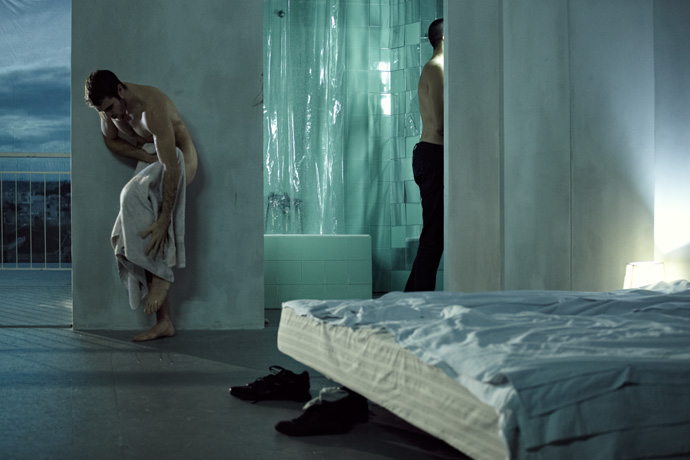 Scene from INSIDE by Dimitris Papaioannou. Photo by René Habermacher
Scene from INSIDE by Dimitris Papaioannou. Photo by René Habermacher
RENE HABERMACHER: Let’s speak a little about your new play: INSIDE.DIMITRIS PAPAIOANNOU: INSIDE is a work born where two situations come together. The first is a show that runs endlessly without beginning, middle or end. The second is a situation in which audiences are allowed to visit at any time they like, sit wherever like, and are free to leave and return as many times as they like. The theatre doors open at 17:30 and close at 23:30. The stage action begins before you come in, and continues after you leave. Nobody sees a beginning, or an end. The play recycles itself, but never repeats itself.
We are playing with the concept of empty time. INSIDE focuses on personal time, that series of moments we experience when we return home. In a way it monumentalises these moments: the very fact of eating, or the very fact of showering, or the very fact of undressing to go to sleep. And without any assistance from civilisation — without a book, a magazine, radio or television.
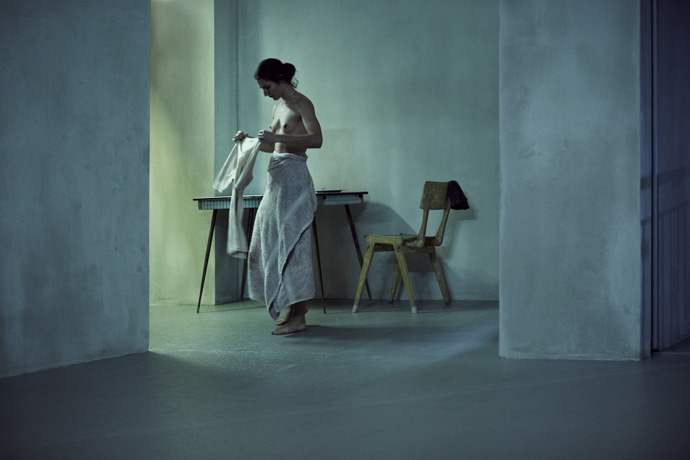
Scene from INSIDE by Dimitris Papaioannou. Photo by René HabermacherWhat you see is a composition, a series of everyday private movements and actions that are exactly the same, repeated multiple times by 30 performers in various overlapping and recycled versions. These phrases come together, then one remains, then another five come into play. It’s about density and overlapping forms. An ongoing open composition that encourages audiences to create their own compositions, depending on how many times, how long and from which angle they choose to see the play.
This is an idea that intrigues me, that people in the centre of the city will visit a theatre to watch others doing things that they do themselves, and the people they watch are themselves watching the city through the window. This is something I feel is charming.
It is these two elements — that of the city documentary exploring a place common to all, and the freedom given to audiences as to how they can view the work — that come together in my view to create this project. The subject of it is one level, the form of it is another, and both are conceived at the same time. This is what interests me, and this is why I am doing it.
So this is what INSIDE is.
I don’t know what people are going to do and how audiences will make use of this game that I am proposing. It’s something of an experiment, we’ll see how it’ll work.
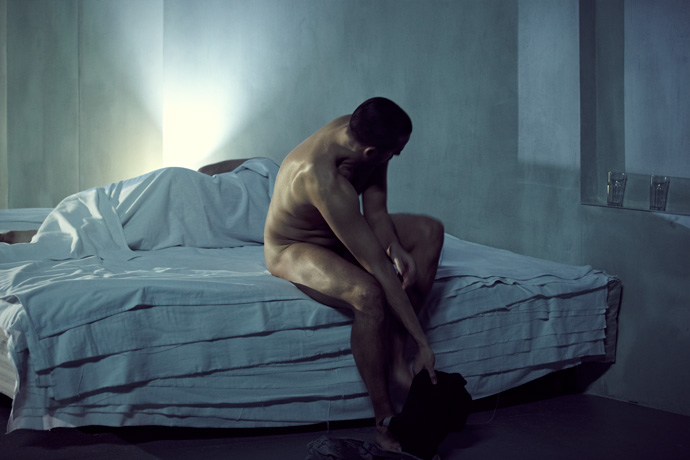
Scene from INSIDE by Dimitris Papaioannou. Photo by René HabermacherIt reminds me of the photographs of Eadweard Muybridge for example, or the performances of Marina Abramović.
Abramović has these elements of patience, and of exhausting the human body. She has done one performance [“The House with the Ocean View”, 2002] where she actually lived in a gallery, in public view, which resembles what I am doing. But my work is not performance art, it requires rehearsal and it will repeat itself everyday; it’s not like an algorithm that evolves organically in front of our eyes. That’s why we are doing it in a theatre and not in a museum or gallery, because it is a kind of a twisted version of a performance, but not performance art. It is something that is rehearsed, that has an acting tone, and is not personal like most performance art, which is about a specific person doing something in that moment. Of course, this experiment of mine would not have been possible if performance art had never existed.
INSIDE reminds you of Muybridge because it gives you the chance to see and imprint in your head the successive stages of a movement, just like Muybridge did in his photographs. They also share the element of observing people: how people move, how they walk.
It’s like filming a documentary in the savannah: you film for hours following a lion and then you have 15 minutes where the lion sits doing nothing. We are taking these 15 minutes of footage of the lion making slight movements and superimposing it many times, through shifts in the timing, to create an entire play out of it. It is still the lion. It’s still about observing the lion. The lion does nothing new. But hopefully we will be magnetised by these successive of layers of the same action taking place, and start meditating upon our own lives.
That was a good example! We are becoming very abstract and intellectual now.
I can’t help it!
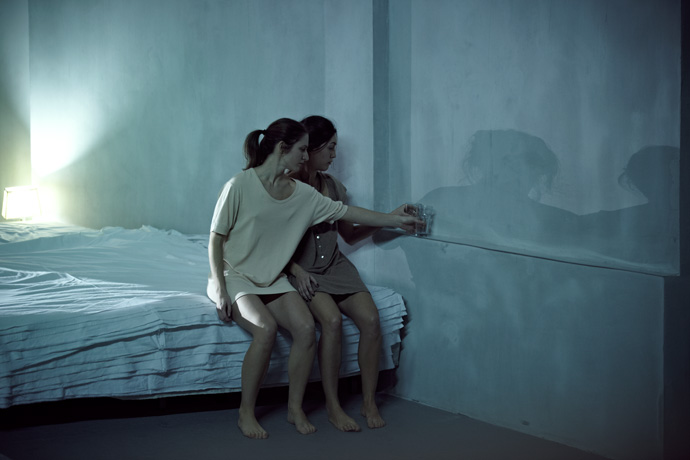
Scene from INSIDE by Dimitris Papaioannou. Photo by René HabermacherI understand that this idea for INSIDE has been in your head for quite a while now.
It was the first thing that came into my head after 2004, the first thing I wanted to do and found worth doing. Back then I had the idea of this room, and of creating a composition from a single simple series of movements by multiplying and superimposing it. Within the framework of a two-hour show, this seemed ridiculous — this limitation would have strangled the idea, forcing the whole thing to have a conclusion, a climax, a very specific story to tell. It would also seem like a joke to audiences, setting them up for something with a beginning, middle and end and then presenting them this thing repeating itself and multiplying, waxing and waning before their eyes, without giving them the chance to leave whenever they want. So I didn’t do it.
Last year, I made the leap in relation to the way the theatre itself could function: I could create a very long show and give people the freedom to come and go as they please. I had to deal with the logistics of the thing, but then suddenly a form was created in which this content could take place. Because once you liberate the audience from having to see it all, then you also liberate the show itself to develop in ways that do not necessarily lead to a defined conclusion. So that is why it is happening now, because it took me some time to conceive the framework within which this could function.
Official trailer for INSIDE.
There are some recurrent elements that I always see on your mood boards, in your work, in your references, and last week I saw a key element once again: the kouros.
Yes!
That one always returns, either standing or fallen.
I deeply apologise, I cannot help it! Some things come back again and again, you know, until everybody will just be exhausted by it and nobody will ever visit anything I do ever again!
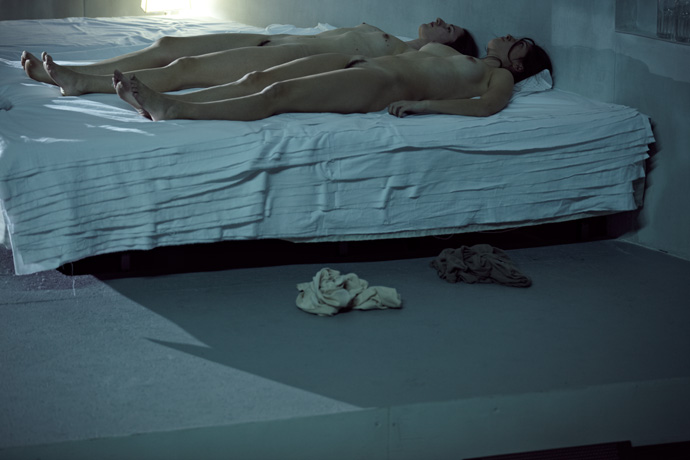
Scene from INSIDE by Dimitris Papaioannou. Photo by René HabermacherWould you say you have an obsession with what the kouros represents: beauty, nobility, youth?
It’s not about youth. It just happens that I work with people who are quite young. I’ve never flinched from the idea of worshipping the structure of a human body: I like the body. I like looking at human bodies. There is something about beauty that charms me and puzzles me and magnetises me.
I have a certain understanding of the human presence, of the human body situated in space and against the vastness of the sky of existence. I usually have people looking at landscapes. I think in every play I’ve done, I’ve had someone looking at something. This is something that maybe comes from me: I tend to breathe things in by looking at them.
When the kouros came to ancient Greece from ancient Egypt, it took one giant step forward: extracted from his background, the axis of his body shifted over his two feet. So for the first time in history, there was a life-size sculpted human figure that could be seen from all sides. And this coincides in ancient Greek history with the dawn of poetry, of lyrical poetry, where people started to talk about how they feel. For me, the kouros is more than a celebration of youth and beauty. I think its more the celebration of wandering. A figure standing on earth, wondering about its own position in space. Wandering in space: where do we stand, where are we? You know, it’s a common puzzle for us humans, and it attracts me. My work reflects that I guess.
Is that enough, dear? Do you want more?! [laughs]
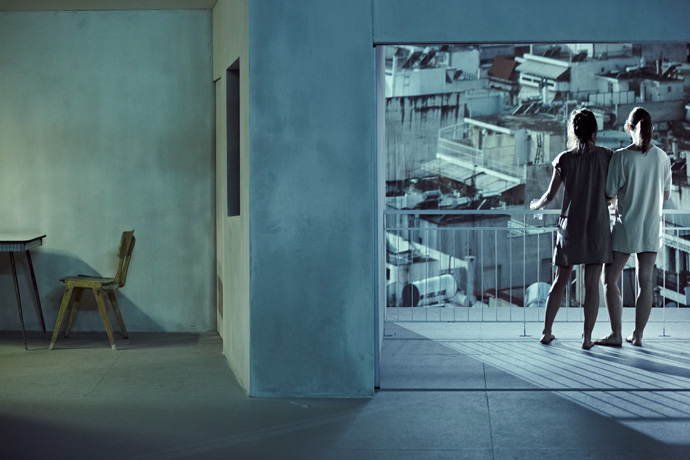
Scene from INSIDE by Dimitris Papaioannou. Photo by René Habermacher -

Efi Spyrou “swings”
-Cypriot Artist Efi Spyrou “swings” to our attention with the latest issue of Pop magazine SS 2011.
Efi Spyrou’s artistic reflection is interdisciplinary, her art on the conjunction of corporality and art theory. Often her approach, as manifested through her pieces and installations, seems cold and industrial. Yet it is charged with personal memories associating emotional moments. Remarkably enough, Efi operates with inhibiting elements of isolation, institutionalisation and discipline to achieve her purpose: ignite an emotional spark.
Efi Spyrou: Swing (1), 2010 marble, latex; 285 x 30 x 15cm. Photo by René Habermacher for PoP magazine SS 2011. Model: Ymre Stimkema.
This Issue of Pop magazine features a group of 5 contemporary artists: Gillian Wearing, Meredith Sparks, Linda Sterling, Clunie Reid and Efi Spyrou, Juxtaposing pieces of her SWING series with fashion by Antonio Marras, her work for this collaboration oscillates around the idea of “lost innocence”.
At this Chapter of her Life, Efi Spyrou contemplates inwards, both on personal and collective memory – after being in the spotlight as a fashion model, presenter and public figure that stood for the right cause:
She was involved in Campaigns of public interest as against eating disorders, “Fashion Targets Breast Cancer” and the UNHCR-the UN refugee Agencies ‘Against Women Trafficking’ and was subsequently awarded with the Cyprus “Leader of the Year in Advertisement”.
THE STIMULEYE finds Efi Spyrou in Athens, her hometown of choice for a conversation on her most recent projects,
including her first solo exhibition at Six D.O.G.S in Athens. The exhibition will run from May 6 2011.Efi Spyrou: Untitled, 2010, latex, iron, plexiglas, wood; 85 x 65 x 120
EFI SPYROU: Hi Rene! Here I am!
RENE HABERMACHER: hey hey- just saw you! welcome!!!!!
I think now it’s a good time for our conversation! Shall we?
In your work we find often references to childhood, as in your most recent SWING series, but as well for example in “Untitled” 2010 (incubator). What is the relation to yourself?
Each detail, each piece reflected on my work is connected to my memories, my experiences especially in my early ages. Sometimes I feel I was literally thrown from childhood to adulthood in an instant moment… There is an inner need to go back again and start from scratch, with a different pace.
How did you grow up?
In a very disciplined way…
I grew up in a very small, conservative, strict, disciplined community where freedom of speech was not something really known… After my 18th birthday, when I decided to leave my homeland Cyprus, I was catapulted into the wild world of which I knew nothing about! And first of all, I knew nothing about rapacity…I was 18 years but I had the feeling to be in fact much, much younger and very scared.
Following your journey had taken you quite somewhere else- in terms of location and orientation. You returned only much later to your point of departure, with your art and the themes your current work embraces.
After 17 years I am in the position to say that this journey was difficult but full of colours, aromas and sounds, the voices of different cultures, people, moments. You see, I have entered the fashion world as a model and subsequently public figure, which gave me the chance to travel a lot all over the world. Although I had great moments, and I do feel lucky about it – I had to test my limits, my values and myself in many ways: In this race the cost was not insignificant. That is why there was a turning point, of explosion, – I had to slow down – and turn the time back, back to my roots and see which were the remains! This is where art gave me the tools to deal with all this material I had in my hands…
Efi Spyrou: Swing (2), 2010, silicone, latex; 75 x 30 x 15cm. Photo by René Habermacher for PoP magazine SS 2011. Model: Ymre Stimkema.
When we met last time in London to do our project for POP, we were focusing on your most recent work, the SWING. In fact it was a juxtaposition of your art with the fashion by Antonio Marras, under the helm of Isabelle Kountoure. It seemed like another circle had closed: with this new pieces that reflect on lost innocence and the interweaving with fashion that had marked another phase of your life.
This was a liberating experience for me. Every time I find the medium to make a conclusion of my contradicting “memory voices”… is an exciting moment. With the series of my works SWING, I had the chance to cooperate with a great team, working on the upside of fashion. And in parallel I had the chance to give light to a darker “space” as you say, “our lost innocence”. This is the only way for me to survive- to accept my bipolarity…
You started with the first piece of your “swing”series in marble. For this project you took cooperations with other people in account – thus creating more facets around the actual object…
The first piece was more an inner conversation. The development of the piece[s] through this cooperation was a conversation with others! This is really important for me, because I do believe that our personal “spaces” from a different perspective are collective “spaces”. The former is the reflection of the latter and vice versa!
In art, the material plays a significant role in the interpretation of the piece.
During our collaborative working process i’ve developed other variants of the original swing: wax, silicone, plaster and mirror. Doing so, I leave an open interpretation of my recent Swings”. What matters to me, is not to give a solution to a problem, but to actually “spark off” something…Swing (3), 2010 by Efi Spyrou: paraffin wax, latex; 335 x 30 x 15cm. Photo by René Habermacher for PoP magazine SS 2011.
As you operate not only plenty with personal memories, but integrate the collective as well – in this context, how important is Athens, or Greece as a background for your work?
For my own work I incorporate a universal, collective memory in my pieces – at least this is what I am trying to do. Sometimes it could be characterised more “western”… but not surely Greek or Cypriot. I can assure you though that my life in Athens and especially the “new” way I look at the city and its everyday life here, gives birth to a lot of new ideas + questions + art pieces!
Spring, especially these days, is so refreshing! I cannot think of economic crisis – I keep my worries silent for the moment.
As far as concerning the emerging art scene over here: I think there is a lot to be done, in order to consider Athens as part of the greater art map. But I see a young art generation which is very promising…What are you working on right now and next?
I am preparing a solo exhibition in May. The show will be running from May 6th at the Six D.O.G.S exhibition space in Athens. Included on display are among new works some ready pieces that are already known.
For the moment I am studying the relationship of memory with the game of lights and shades in space. I am working on sketches right now, may be for an installation, we will see…
I would love to have the chance for more collective dialogues in the future.Efi Spyrou: Swing (2), 2010, silicone, latex; 75 x 30 x 15cm. Photo by René Habermacher for PoP magazine SS 2011.
Thank you so much for this insightful talk!
Shall I say sweet dreams?
Efi Spirou’s solo exhibition at Six D.O.G.S, 6-8 Avramiotou Street, 10551, Athens, Greece
The exhibition will run from May 6 2011.a collaboration EFI SPYROU | ANTONIO MARRAS pop Magazine SS 2011
Hair Panos Papandrianos at CLM using Bumble and bumble
Make-up Yannis Siskos at Effex using Giorgio Armani Cosmetics
Model Ymre Stiekema at Viva London
Casting Angus Munro at AM Casting, Streeters NY
Set Design Emily Pugh
Photography Assistance & Digital Technician Laurent Dubin
Fashion Assistance Tui Lin
Hair Assistance Angel Sayers
Digital Remastering Dimitri Rigas at Dimitri.jp
Shot at The Russian Club Studios -

Next: EFI SPYROU
-“The tales interwoven with the remains of memories, carved by lights and shades into a living space that no longer exists.”
-

dimitris papaioannou : spatial and human relationships
-SPATIAL AND HUMAN RELATIONSHIPS
Continuing the conversation with Greek choreographer Dimitris Papaioannou, this second part concentrates on his post olympic work as MEDEA2 and the influences of butoh and his native Athens in his work.
 Scene from MEDEA2 by Dimitris Papaioannou. Photo by René Habermacher
Scene from MEDEA2 by Dimitris Papaioannou. Photo by René HabermacherRENÉ HABERMACHER: Over the years your journey has brought your work to ever-larger audiences. Recently, with your play MEDEA2, you revisited the past. How was that experience?
DIMITRIS PAPAIOANNOU: It challenged me for a number of reasons. If you follow my journey, I was violently exposed to the general public with the success of the Opening Ceremony of the Athens Olympic Games. In order to recover from the experience, I had to take a two-year break.
The first thing I chose to do after this pause was a show called 2. 2 was actually an attempt to pick up where I had left off before the ceremony, to return to my roots and re-evaluate my work. I constructed a very personal show on a large scale because I was offered the opportunity to do so, and I tried to restart my interrupted line of development in an unusual way.
After this experience many question marks arose, and I realised that I was still exposed to a much larger public than I was used to. I had the feeling that there was a new kind of communication being created that was both charming and dangerous. I needed more time before taking my next step.
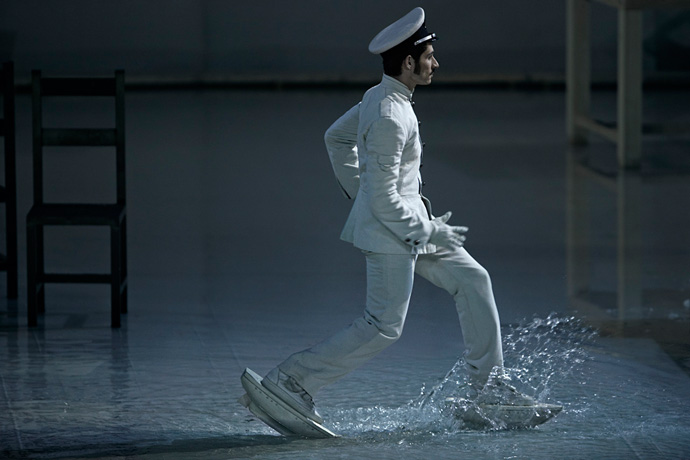 Jason crossing the sea. Scene from MEDEA2 by Dimitris Papaioannou. Photo by René Habermacher
Jason crossing the sea. Scene from MEDEA2 by Dimitris Papaioannou. Photo by René HabermacherMany people were suddenly exposed to my work through the Olympics, but of those who had a real interest, many were too young to have experienced MEDEA. So I returned to MEDEA, attracted by the idea of presenting it again with an all new cast, and approaching it with a new idea: to take the passion out. I wanted to reconstruct it, refine it, clear it out, strip it of anything unnecessary, drain the blood from the performance and deliver it in the cleanest form I could manage. That was my intention with MEDEA2.
Having done that, I could continue with new work, first NOWHERE and now INSIDE. This is a completely new phase, where I am tending to create shows with no protagonists and no characters. The crowd is the element I’m focusing on now, using it in a more open structure in order to create images involving spatial and human relationships.
Excerpts of MEDEA 2 accompanied by interview with Dimitris Papaioannou.
-

dimitris papaioannou : a pasolinian touch
-Dimitris Papaioannou’s work as a choreographer has significantly reshaped the Greek performing arts landscape.
With his directing of the Athens 2004 Olympic Games Ceremony, a ground-breaking success, he played his way straight in the heart of the spectators, hailed a “triumph” by TIME MAGAZINE and THE TIMES of LONDON.In 2005 Dimitris Papaioannou was awarded the Golden Cross of the Order of Honour by the President of the Hellenic Republic for outstanding artistic achievement. For his following shows “2″ and MEDEA2 enjoyed an unprecedented run in the Greek capital, each with over 100 000 tickets sold. This accelerated development came not without controversy. With his latest play INSIDE Dimitris returns to his experimental roots.
THE STIMULEYE met with him during a break of rehearsals in Athens, to speak about his new play and look back to his point of departure.
Following the first part of three on the conversation with Dimitris Papaioannou, accompanied with exclusive pictures by René Habermacher.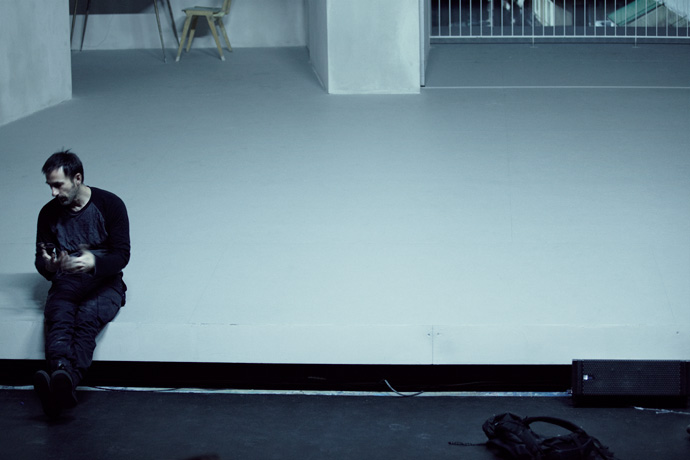 Dimitris Papaioannou on the rehearsal set for his new play INSIDE. Photo by René Habermacher
Dimitris Papaioannou on the rehearsal set for his new play INSIDE. Photo by René Habermacherpasolinian touch
DIMITRIS PAPAIOANNOU: I’ll be right with you — I’m just making a coffee!
RENÉ HABERMACHER: You’re freshly shaven! You look very 19th-century with your moustache.
I am from the 19th century honey, I’m very old!
It’s been a while since we had time for a talk, since I left Athens and you last visited Paris. We met only briefly during the rehearsals for your new play INSIDE, which you’re currently working on. You spent last Spring in New York. Tell me about what you did there.
I was there from March until June on a Fulbright Artist’s Scholarship. A mid-career scholarship obviously… [laughs]
Actually in a way I was studying the story of performance art [with Laurie Anderson at The Kitchen NYC] and developing my Final Cut Pro skills, as well as experiencing a little more of New York life, now that I’m a mature boy and things are different!
How was it returning to Athens after that?
For me it was a blessing because I discovered that I had left New York when I was still under construction. It’s the perfect place to be when you are like that, but in this phase of my life what I found there was a little more superficial than I would have liked. The Athens I returned to was in complete economic crisis and emotionally depressed, but still I was deeply relieved to spend summer back home.
Dimitris, I know you were born in Athens, but we’ve never talked about your childhood.
I was born and grew up in Athens, in a lower-middle class family. My parents made financial sacrifices so that I could go to a very expensive school, the Athens College. Then I had to run away from home because my parents wanted me to live the life of a straight architect. But I was a gay man, and I wanted to be a painter. I became the student of the Greek painter Yannis Tsarouchis* (1) in the old fashioned way, where painters trained people in their atelier. It was there I was introduced to true art. I had been painting since I was a child, but it was when I met Tsarouchis that I realised what painting really was. Later I entered the Athens School of Fine Arts.
* (1) : Yannis Tsarouchis, 1910-1989 One of the most important twentieth-century Greek painters, Yannis Tsarouchis portrayed and helped to define modern Greek identity. The deeply sensual painter was much influenced by the French impressionists and often depicted sailors, soldiers and the nude male body in erotic situations.
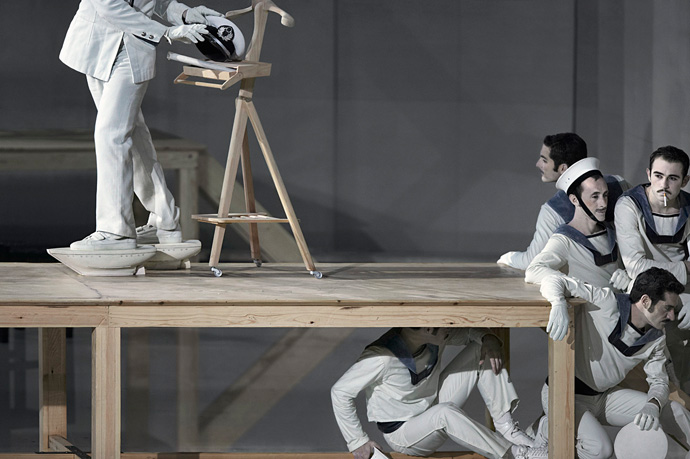 The departure of Jason in reference to Yannis Tsarouchis. Scene from MEDEA2 by Dimitris Papaioannou
The departure of Jason in reference to Yannis Tsarouchis. Scene from MEDEA2 by Dimitris PapaioannouHow did you meet Tsarouchis?
I knocked on his door. I showed him some my paintings and asked for his comments. He was not cruel, as he could have been, about those awkward early drawings — instead he was very polite. My college had organised an exhibition of my work in the building’s library, so I invited Tsarouchis to see my work up close. The next day he called me and invited me back to his house, after which he allowed me to watch him paint, and would give corrections on my paintings. I became his student.
How did this encounter shape you? Did it leave a mark on your artistic work?
Well, your first mentor leaves a strong mark on your life. I grew up in a house that had no contact with artists, there wasn’t a single painting on the walls. My parents weren’t very fond of art, it wasn’t part of their lives. I felt like an alien, wanting to enter this world. So Tsarouchis was the first artist I really saw working, and I realised that the life of an artist is possible and, to my eyes, very charming. I felt at home in a way. And he was a great painter. He had a quality that interests me a great deal: he could make magic with the humblest of materials — he could make roses out of toilet paper, use wires to make small sculptures. The thing I think I have learned from him is that you can make poetry out of garbage.
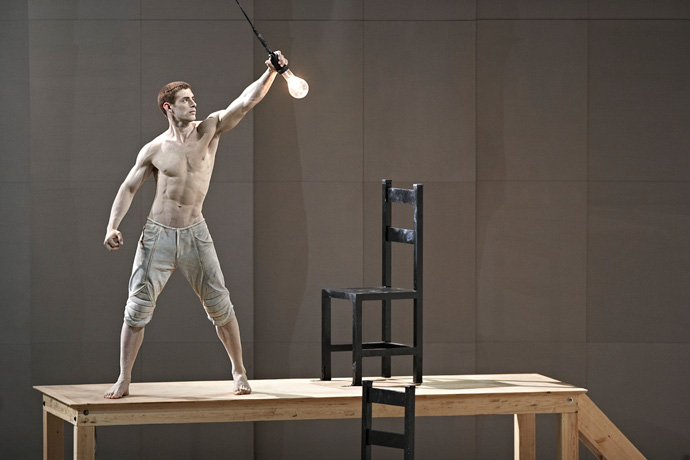 “Helios”. Scene from MEDEA2 by Dimitris Papaioannou. Photo by René Habermacher
“Helios”. Scene from MEDEA2 by Dimitris Papaioannou. Photo by René Habermacher -

next: dimitris papaioannou
-A quote from Rumi, the Persian sufi, translated by Coleman Barks:
“When you brush a form clean, it becomes what it truly is” -

sensibility embedded in its fabric
-The Victoria and Albert Museum presents one of the most influential and enigmatic fashion designers of the last forty years: Yohji Yamamoto. Shortly before the opening, THE STIMULEYE caught up with V&A Contemporary Curator Ligaya Salazar, curator of this installation-based retrospective, exploring the work of a designer who has challenged, provoked and inspired with designs that have rewritten notions of beauty in fashion.
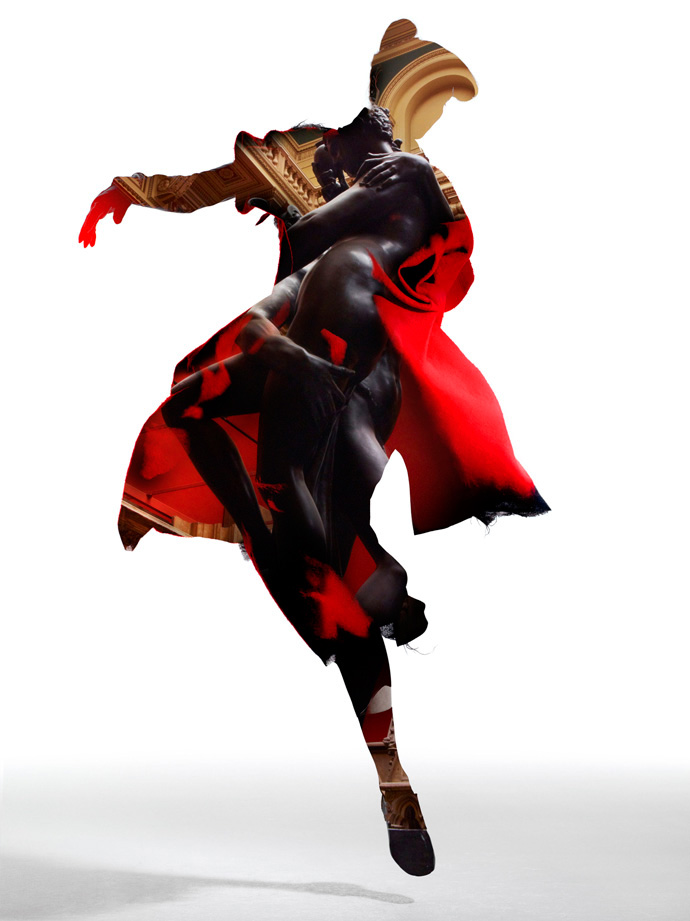 YOSHJI YAMAMOTO Photography Nick Knight, Art Direction Peter Saville
YOSHJI YAMAMOTO Photography Nick Knight, Art Direction Peter Saville“The timeline will consist of a mixture of clips of key fashion shows from the last 30 years of his illustrious career, some bits about his main collaborations in film, performance and photography and some very special extras. I hope that this will help shed light on Yamamoto’s extraordinary approach to collaboration” – Ligaya Salazar
On display are 80 women’s and menswear garments, which are most representative of his work that is recognised for subverting gender stereotypes and has featured women wearing garments traditionally associated with menswear. The exhibition also includes menswear items from the Autumn/Winter 1998 season which was famously modelled on women.
Accompanying the exibition, Ligaya produced a series of images with Nick Knight, styled by Katie Grand, and edited a stunning Book that also sheds light on Yoshji Yamamoto’s relationships with other creative collaborators: including Peter Saville, Marc Ascoli and M/M (Paris), Pina Bausch and filmmakers Takeshi Kitano and Wim Wenders.
René Habermacher sat down with curator Ligaya Salazar for a chat on this and her curatorial work on the projects…
RENE HABERMACHER: Hello Ligaya! how is things? Tense, so short before the opening?
LIGAYA SALAZAR: Ha! We are actually a little ahead of schedule, awaiting Yohji’s visit
Now i am impressed!
Yes he will be coming to the V&A after his Ready-to-Wear show to check everything is in order and to paint on the gallery walls!
I would assume usually that would come first- the painting….
Oh no — not painting the gallery walls, he will be painting life-size silhouettes on the wall behind and amongst the mannequins. It will be very special.
(more…)
